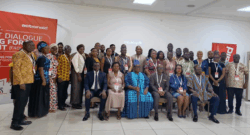The ever-changing competitive global business environment demands that businesses must constantly analyse their human capital base to ascertain whether the skills available in the organisation can match the competencies required to compete successfully in the market; hence the need to have human resource planning as part of the overall human resource planning strategy. In fact, organisations need to identify the number of people and the level of skills and expertise they should have to meet present and future business requirements.
Bulla and Scott (1994) defined workforce or human resource planning as the process for ensuring that the human resource requirements of an organisation are identified and plans are made for satisfying those requirements.
Reilly (2003) defined workforce planning as a process in which an organisation attempts to estimate the demand for labour and evaluate the size, nature and sources of supply which will be required to meet that demand. Quinn Mills (1983) defines workforce planning as a decision-making process that combines three important activities: identifying and acquiring the right number of people with the proper skills; motivating them to achieve high performance; and creating interactive links between business objectives and people planning activities.
Farnham (2006) stipulates that workforce planning is important because it encourages employers to develop clear and explicit links between their business and human resource plans, and to integrate the two more effectively. Workforce planning therefore involves working through four issues:
- The composition and content of the workforce that will be required to strategically position the organisation to deal with its possible future and business objectives.
- The gaps that exist between the future ‘model’ organisation(s) and the existing organisation, including any special skills required by possible futures.
- The recruiting and training plans for permanent and contingent staff that must be put in place to deal with those gaps.
- The determination of the outside sources that will be able to meet the skill needs for functions or processes that are to be outsourced.
For the workforce planning process to be successful, human resource professionals responsible for leading workforce planning initiatives should make sure to: designate a specific member of the HR team to manage the process; find a high-level executive to champion the plan; involve key stakeholders in the workforce planning process; align the plan with the company’s strategic business plan; coordinate the workforce plan with succession planning and career development initiatives; and make workforce planning an ongoing activity, with continuous evaluation of changes in the internal and external environment which may affect the organisation’s staffing needs. It’s worth noting that the following distinct analytical steps need to be taken in workforce planning:
- The supply analysis – involves an analysis of an organisation’s current labor supply.
- The demand analysis – includes a review of future business plans and objectives.
- The gap analysis – compares differences in the supply and demand models and identifies skill surpluses and deficiencies.
- The solution analysis – focuses on how to address gaps in current staffing and future staffing needs through recruiting, training and development, contingent staffing, and outsourcing.
Environmental Scanning
Scenario planning is an assessment of environmental changes that are likely to affect the organisation; and as a result, a prediction can be made of the possible situations which may have to be dealt with in the future. The scenario may list a range of predictions so that different responses can be considered. In fact, the scenario is best based on systematic environmental scanning, possibly using PEST analysis.
Demand forecasting
Demand forecasting is the process of estimating future numbers of people required and the likely skills and competences they will need. The demand model’s purpose is to forecast the organisation’s future workforce composition. This forecast should take into consideration a broad range of business issues – including new product lines, competitive forces and expansion or constriction in global marketplaces, anticipated workforce availability within geographic boundaries, and myriad other issues. In fact, internal and external factors need to be considered in the demand analysis. Analyses of internal demand influences may focus on the following questions, among others:
- Will the current workforce, with minimal retraining, have the skill sets necessary to perform new duties with a new product line within the organisation?
- Will current employees remain loyal to the organisation if it has anticipated changes in mind?
Indeed, analyses of external demand influences may consider these questions:
- Is labour readily available that possesses the skills and abilities needed by the organisation?
- What external pressures will change demand for goods and services that may ultimately affect internal business decisions and, thus, workforce planning needs of the organisation?
The demand forecasting methods for estimating the number of people required are:
- Managerial judgement: This method requires managers of the organisation to sit down, think about the future workloads, and decide how many people they need in terms of skills and competence.
- Trend analysis: Ratio trend analysis can be used by management to forecast future labour needs of the company. Activity level forecasts are used to determine direct and indirect labour requirements for the organisation.
- Work study techniques: This technique can be used when it is possible to apply work measurements to calculate how long operations should take and the number of people required.
Supply forecasting
Supply forecasting measures the number of people likely to be available from within and outside the organization – having allowed for absenteeism, internal movements and promotions, wastage and changes in hours and other conditions of work. The purpose of the supply model is to analyse the organisation as it currently exists – thus, the supply of labour and skill sets that are vital to an organisation. This analysis should encompass not only the number of employees and their skills, but also factors such as workforce demographics and representation of protected classes.
A supply analysis also involves making projections of attrition; that is, due to resignations, retirements, internal transfers, promotions and involuntary terminations over the planning horizon being used, so that attrition is taken into account in considering the future supply of labour and skills.
Gap analysis
The next step in the process seeks to compare the supply model with the demand model to identify gaps between the composition of the current workforce and future workforce needs. The workforce planning professional may want to categorise a variety of future scenarios and then select the future that is most likely to occur, with contingency planning for alternative futures. When conducting this analysis, the planner should identify the additional number of employees needed who have the requisite skill sets, as well as the employees who will no longer be needed due to limited skill sets
Solution analysis
After managers have identified the gap, the next step is solution analysis. Solution analysis involves the development of strategies to close the gaps identified in the previous step. Approaches for meeting future workplace demands of the organisation may include recruiting, training and retraining, using contingent staff, or outsourcing. The approaches selected will be dependent on whether the organisation will need to expand, contract, restructure or rely on contingent staff to meet new workplace demands.
- Recruiting –When external staff is required to meet a workforce expansion due to demands of new product lines, expanded production or service offerings, or new geographic areas to be served, external recruitment may be the logical strategy to address gaps. Recruiting may also be required as turnover occurs, whether due to employees leaving to find other employment opportunities or due to retirement.
- Training and retraining –Instead of filling the skills gaps through external recruiting, Human Resource Managers may choose the less costly solution of employee development, particularly for key high-value positions. Employee development builds on current intellectual capital, retains the corporate culture, and motivates and stimulates the workforce. As skill sets become obsolete due to new technology, new services, additional product lines or other competitive forces, the organisation should focus on updating the skills and capabilities of their employees as a critical workforce planning strategy.
- Contingent staffing – When the current number of employees or their skills sets are insufficient to accomplish the work, given the anticipated business future, contingent staffing may be used to fill that gap. This approach makes sense when the demand model indicates that the numbers of employees will vary significantly and cannot be levelled out through resource allocation strategies.
- Contract workers and consultants – Sometimes an organisation may need workers who have specialised knowledge or expertise to help meet new business requirements. Independent contractors and consultants may be used to meet these special requirements.
Conclusion
It is worth noting that workforce planning is key and critical to delivering the overall strategy of an organisation, and therefore it must be done holistically to ensure the required human capital is in place or well-equipped to meet future demands and changes in the business environment.
References
- Bulla, D N and Scott, P M (1994) Manpower requirements forecasting: a case example, in (eds) D Ward, T P Bechet and R Tripp, Human Resource Forecasting and Modelling, The Human Resource Planning Society, New York.
- Farnham, D (2006) Examiner’s Report (May), CIPD.co.uk Marchington, M and Wilkinson, A (1996) Core Personnel and Development, Institute of Personnel and Development, London
- Quinn Mills, D (1983) Planning with people in mind, Harvard Business Review, November–December, pp 97–105
- Reilly, P (1999) The Human Resource Planning Audit, Cambridge Strategy Publications, Cambridge
- Reilly, P (2003) Guide to Workforce Planning in Local Authorities, Employers’ Organisation for Local Government, London.
>>>The writer is a Development Economist and Chartered Financial Analyst. Daniel is the Chief Economist at the Policy Initiative for Economic Development. He also the Director of Research and Analysis, B&FT. He can be reached on email: [email protected]. Tel; 0244 476376/ 0201939350










